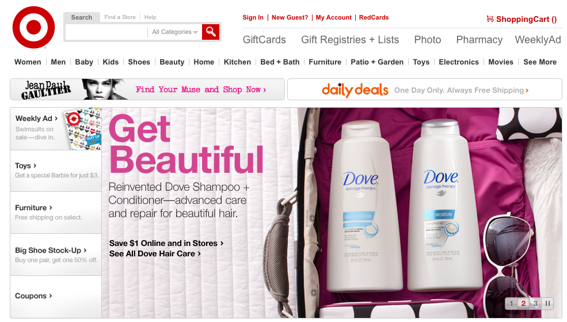Target.com is well known in the world of web accessibility. It was sued in 2006 by the National Federation of the Blind, Bruce F. Sexton, Jr., and the National Federation of the Blind of California because its website was not accessible to visually impaired shoppers. The lawsuit was ultimately settled in 2009, and Target Corporation was required to make its website accessible to the blind.
Target.com home page.
How Target.com Fares Today
In February 2010, the National Federation of the Blind granted Target.com “Nonvisual Accessibility Web Certification,” asserting that the website is now equally usable by blind and sighted users, making Target.com one of the first major retail websites to implement web accessibility.
Since implementing the required revisions to its website, Target.com can now be navigated easily and successfully for the purchase of goods by individuals using screen readers. Visitors can now access descriptive information contained in images, and without the burden of gibberish information caused by images with missing alt attributes.
The adjustments for blind users are a significant improvement. However, the site still contains many barriers to individuals with low vision or keyboard dependencies, and it is still critically flawed from a web accessibility standpoint.
Problems With Keyboard Navigation
One of the more serious problems is in its skip link functionality. (Skip links allow screen readers to skip over navigation items to arrive at the page content, saving much time for screen reader users.) Although the presence of skip links is excellent, they are only truly valuable if they work. The problem is that nearly every page includes the same two skip links, for the main content area and for the left navigation, respectively. Unfortunately, the main content link points to a location that only exists on third-level subcategory pages (e.g. Home Page > Furniture > Home Office > Desks) and individual product pages (e.g. Delano Desk – Antique Black) This means it has no effect when used on primary categories, supplemental pages or, most importantly, shopping cart pages.
Although individual product pages and third-level subcategories certainly constitute the greatest volume of documents on Target’s website, the shopping cart pages are documents which every single shopper must visit to complete a purchase. The inability to skip over the main navigation on these pages is a significant inconvenience for the keyboard navigator.
A lack of functioning skip links doesn’t actually destroy the accessibility of a site, but it does significantly decrease the usability of the site for users who depend on a keyboard, and it tests a user’s faith that the accessibility features he or she uses will work. In addition to a failure to function dependably, these links have no separating character or HTML element, leading to a probable run-on voicing by screen readers.
A second problem, and one that also has a significant impact on keyboard navigators, is a lack of keyboard-activated focus on links. The main navigation has strong keyboard focus, with a color change and the addition of an underline. However, supporting links and image links have no focus beyond the default browser focus, a subtle indicator at best. And, some of these supporting links are particularly important pages, such as the functions to remove or edit items in the shopping cart, the Target.com privacy policy, and the store finder, to name a few.
Problems With Contrast
The site also exhibits some unfortunate contrast problems. Many links are designed with a text color of #999 over a background color of #fff. This color combination fails to pass color contrast requirements under either Web Accessibility Guidelines 1 (WCAG 1) or WCAG 2, even if the links are presented in large text, which the links in question are not. These low contrast links (some of the same links lacking keyboard focus indicators) point to a number of important pages and functions throughout the site, including the privacy and security, cookies and targeted advertising, and site terms and conditions.
Conclusion
Simply making a website accessible to the blind is not the end goal for web accessibility. And, while Target’s website has been thoroughly revised according to the terms of its lawsuit settlement, those terms only covered a portion of the issues relevant for website accessibility. Target Corporation has done an admirable job of meeting the requirements demanded by the settlement, but its website still needs further improvements to become accessible to all.




